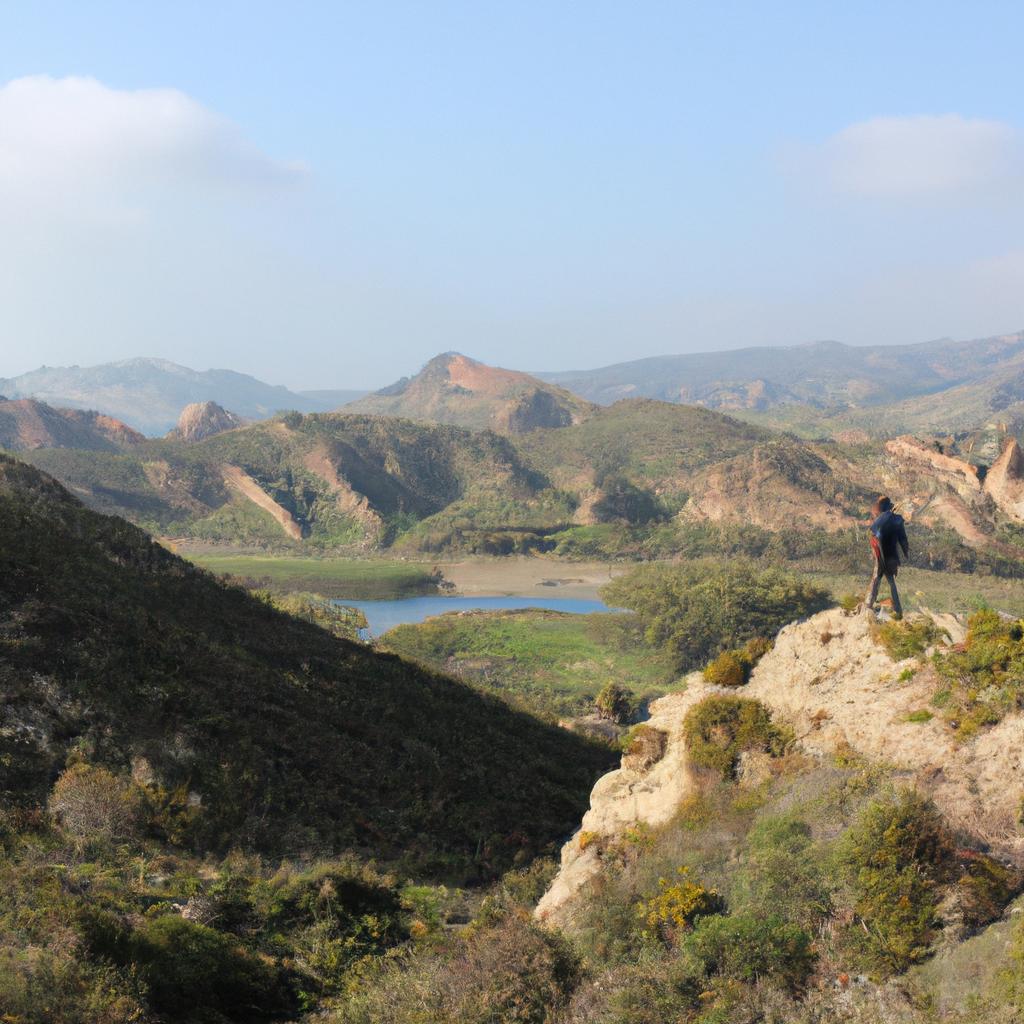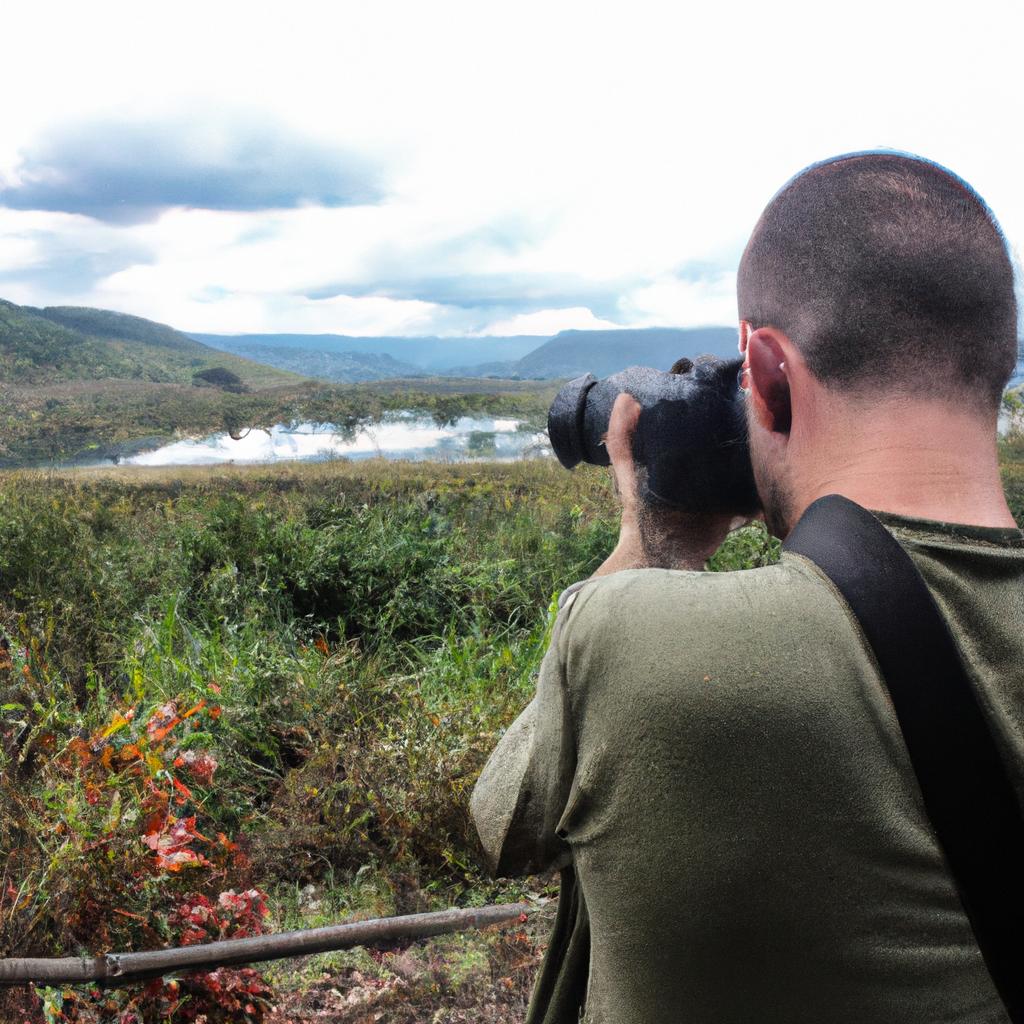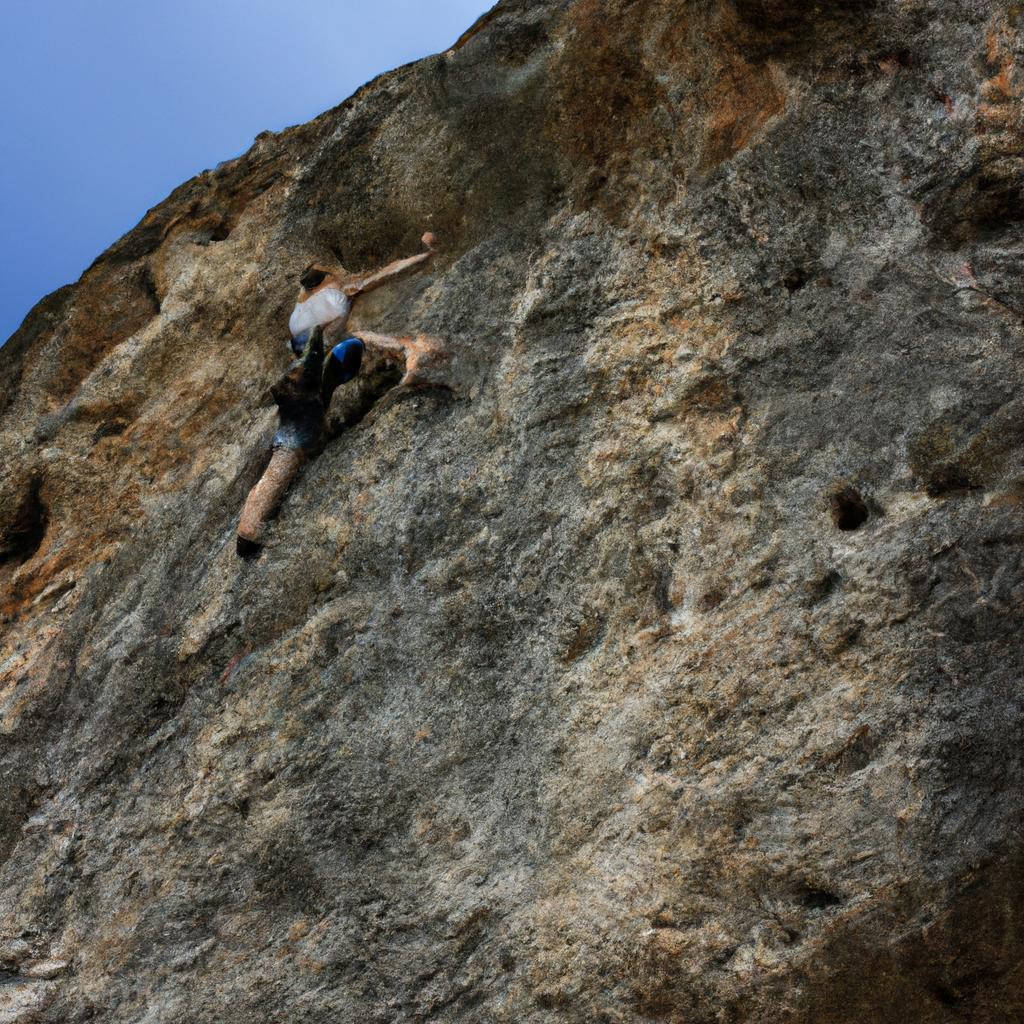Backpacking North America offers a myriad of opportunities for outdoor adventure enthusiasts seeking to immerse themselves in the breathtaking landscapes and diverse cultures that make up this vast continent. From traversing the rugged trails of the Rocky Mountains, to exploring remote national parks such as Yosemite and Banff, backpackers can experience firsthand the beauty and untamed wilderness that North America has to offer. This article aims to provide an academic exploration of the allure of backpacking in North America, examining its benefits, challenges, and potential impacts on both individuals and the environment.
To illustrate the transformative power of backpacking in North America, let us consider a hypothetical case study involving Sarah, a young traveler from Europe. Having grown up amidst bustling cities and urban landscapes, Sarah yearned for an escape into nature’s embrace. She embarked on a solo backpacking journey through North America with only her trusty pack on her back and a thirst for discovery in her heart. As she hiked along winding trails surrounded by towering trees and majestic mountains, Sarah experienced a profound sense of awe and connection with the natural world around her. The serenity found within these untouched landscapes allowed her to disconnect from the demands of modern life, fostering personal growth and self-reflection along her expedition. Through this example, Through this example, we can see how backpacking in North America can provide individuals like Sarah with a transformative experience that allows them to reconnect with nature, find inner peace, and gain a deeper understanding of themselves and the world around them. The physical challenges of hiking for long distances, navigating unfamiliar terrain, and carrying all their essentials on their backs also build resilience and self-confidence.
Furthermore, backpacking in North America offers numerous environmental benefits. By immersing themselves in nature and practicing Leave No Trace principles, backpackers minimize their impact on fragile ecosystems and contribute to the preservation of wilderness areas. Through firsthand experiences of the beauty and vulnerability of these landscapes, backpackers often become passionate advocates for conservation efforts.
However, it is important to acknowledge the potential challenges and impacts associated with backpacking in North America. These include safety concerns such as encounters with wildlife or getting lost in remote areas. Additionally, the increasing popularity of outdoor recreation can lead to overcrowding in certain destinations, putting strain on local resources and ecosystems if not managed sustainably.
In conclusion, backpacking in North America offers immense opportunities for personal growth, adventure, and connection with nature. Through responsible exploration and appreciation for the natural world, individuals can create lasting memories while contributing to the conservation of these precious environments. Whether it’s exploring iconic national parks or discovering hidden gems off the beaten path, backpacking in North America is an experience that leaves a lasting imprint on both individuals and the environment they explore.
Planning your backpacking route
Planning your backpacking route is an essential step in ensuring a successful and enjoyable adventure across North America. By carefully considering various factors such as time, budget, interests, and physical capabilities, you can create a well-rounded itinerary that maximizes your experience.
To illustrate the importance of planning, let’s consider a hypothetical example. Imagine you’re a nature enthusiast from Europe embarking on a three-month journey to explore North America’s diverse landscapes. Without proper planning, you might find yourself overwhelmed with choices or underprepared for challenging terrains. However, by taking the time to plan ahead, you can optimize your route and make the most out of your limited time.
One effective way to approach this task is by creating a checklist of considerations:
- Time constraints: Assess how much time you have available for your trip and allocate it accordingly among different regions or attractions.
- Budget allocation: Determine how much money you are willing to spend on transportation, accommodation, food, and activities throughout your journey.
- Interests and preferences: Identify what aspects of outdoor adventure appeal to you the most – whether it’s hiking through scenic mountains or kayaking along picturesque coastlines.
- Physical abilities: Be honest with yourself about your fitness level and choose routes that align with your capabilities while still offering enough challenge.
| Factors | Considerations |
|---|---|
| Time | Allocate wisely |
| Budget | Plan expenditures |
| Interests | Personalize route |
| Abilities | Match difficulty |
By organizing these considerations into an easy-to-reference table format like above, it becomes easier to evaluate different options and reach informed decisions when piecing together your backpacking route. Remember that flexibility is key; unexpected opportunities may arise during your travels that require adjustments to your plans.
With careful planning complete, our next section will delve into some must-visit national parks in North America. These awe-inspiring destinations offer breathtaking natural beauty and a wide range of outdoor activities, making them ideal additions to any backpacking itinerary. So, let’s explore the wonders that await!
Must-visit national parks in North America
Imagine standing on the edge of a glacier, surrounded by towering peaks and shimmering blue ice. This is exactly what awaits you in Glacier National Park, one of the many breathtaking national parks in North America. From snow-capped mountains to vast deserts and lush rainforests, this continent offers an incredible range of landscapes that are just waiting to be explored.
When planning your backpacking adventure through North America, it’s essential to consider the diverse natural wonders that this region has to offer. Here are some must-visit national parks that will leave you awe-inspired:
- Yosemite National Park (California): Home to iconic landmarks like El Capitan and Half Dome, Yosemite boasts dramatic granite cliffs, cascading waterfalls, and ancient sequoia groves.
- Banff National Park (Canada): Located in the heart of the Canadian Rockies, Banff showcases turquoise glacial lakes, rugged mountain ranges, and abundant wildlife such as grizzly bears and elk.
- Grand Canyon National Park (Arizona): Carved by the mighty Colorado River over millions of years, the Grand Canyon is a geological wonder with its colorful rock formations stretching for miles.
These national parks not only provide unparalleled opportunities for hiking and camping but also serve as important conservation areas for protecting biodiversity. In fact, they contribute significantly to maintaining ecological balance while offering visitors a chance to reconnect with nature.
The table below highlights some key features of these remarkable destinations:
| National Park | Key Features |
|---|---|
| Yosemite | Majestic granite cliffs, thunderous waterfalls, giant sequoias |
| Banff | Turquoise lakes, towering peaks, diverse wildlife |
| Grand Canyon | Vast canyon walls displaying layers of earth’s history |
Visiting these extraordinary places allows travelers to expand their horizons beyond everyday life. Immerse yourself in the beauty of untouched landscapes, and let the awe-inspiring wonders of North America captivate your senses.
Transitioning into the next section about “Essential gear for backpacking,” it is important to ensure that you are properly equipped for your outdoor adventure. By having the right gear, you can make the most out of your backpacking experience while staying safe and comfortable along the way. Let’s explore what essentials should be on every backpacker’s checklist.
Essential gear for backpacking
Unleashing the hidden gems of North America’s national parks is an unparalleled experience for adventure enthusiasts. Exploring these breathtaking landscapes not only offers a chance to witness majestic wildlife and stunning vistas but also provides an opportunity to connect with nature on a deeper level. To make the most out of your backpacking journey, it is crucial to be well-prepared with essential gear that ensures comfort, safety, and functionality.
Consider this hypothetical scenario: Imagine yourself standing at the entrance of Yosemite National Park in California. The towering granite cliffs, cascading waterfalls, and lush meadows beckon you into a world of natural wonders. As you embark on your backpacking expedition through this iconic park, proper equipment becomes indispensable. Here are four key items that will enhance your outdoor adventure:
- Sturdy Backpack: A reliable backpack designed specifically for hiking and camping is essential to carry all your supplies comfortably.
- Quality Hiking Boots: Invest in durable hiking boots that provide ankle support and traction on various terrains, ensuring stability throughout your journey.
- Lightweight Tent: Opt for a lightweight tent that can withstand different weather conditions while providing adequate shelter during overnight stays.
- Water Filtration System: Accessible freshwater sources may be scarce or contaminated in some areas. Carry a water filtration system to ensure a safe drinking supply throughout your trip.
To further assist you in planning your backpacking adventure effectively, refer to the following table showcasing additional recommended gear options:
| Gear Item | Purpose | Recommended Brand |
|---|---|---|
| Sleeping Bag | Provides warmth and insulation during cold nights | Marmot |
| Headlamp | Illuminates surroundings during nighttime activities | Black Diamond |
| Portable Stove | Allows cooking meals on-the-go | MSR |
| Trekking Poles | Offers stability and reduces strain on joints | Black Diamond Distance Z |
By equipping yourself with these essential items, you can embark on a backpacking journey that ensures convenience, safety, and an immersive connection to the natural wonders of North America’s national parks.
Transition into the subsequent section: As exciting as backpacking sounds, it is crucial to plan your adventure while keeping budget constraints in mind. Let us now explore some valuable tips for enjoying a wallet-friendly exploration of these captivating landscapes.
Tips for budget-friendly backpacking
Imagine embarking on a backpacking trip through the vast wilderness of North America. The possibilities are endless, from hiking through towering mountain ranges to exploring dense forests and pristine lakeshores. One such destination that showcases the diverse beauty of this continent is Banff National Park in Canada. Nestled in the heart of the Canadian Rockies, it offers an unparalleled experience for outdoor enthusiasts.
To truly appreciate these natural wonders, having essential knowledge and skills becomes crucial. Here are some tips to enhance your backpacking adventure:
-
Plan Ahead:
- Research the area you plan to visit, including trail conditions and regulations.
- Make sure to obtain any necessary permits or passes beforehand.
- Prepare a detailed itinerary with estimated distances and camping spots along the way.
-
Pack Wisely:
- Invest in quality gear suitable for various weather conditions.
- Carry lightweight but durable equipment, ensuring comfort while minimizing strain on your body.
- Remember to pack enough food supplies and purifying methods for water sources encountered during your journey.
-
Practice Leave No Trace Principles:
- Respect nature by leaving minimal impact on the environment.
- Dispose of waste properly and follow designated trails to avoid damaging fragile ecosystems.
- Be mindful of wildlife habitats and maintain a safe distance when observing animals.
Embarking on a backpacking trip allows us not only to explore nature’s splendor but also teaches us valuable lessons about self-reliance, resilience, and adaptability. By immersing ourselves in the great outdoors, we gain a deeper appreciation for our planet’s treasures.
As we venture further into our exploration of backpacking North America, it is important to prioritize safety precautions for outdoor trips. Taking proactive measures ensures an enjoyable experience without compromising well-being or causing harm to oneself or others.
Safety precautions for outdoor trips
Transitioning from the previous section’s budget-friendly tips, we now turn our attention to exploring off-the-beaten-path destinations in North America. Imagine discovering hidden gems that are not typically found on tourist maps or travel brochures. Let us delve into this exciting aspect of backpacking and uncover unique experiences waiting to be explored.
One such example is the remote town of Tofino, located on Vancouver Island in British Columbia, Canada. Tucked away amidst lush rainforests and pristine beaches, Tofino offers a serene getaway for nature enthusiasts seeking solace from bustling city life. Visitors can embark on breathtaking hikes through Pacific Rim National Park Reserve, witness majestic whales during guided boat tours, or simply relax by building sandcastles on Long Beach. By venturing beyond popular tourist spots, travelers gain an authentic sense of place and create memories that last a lifetime.
To make your off-the-beaten-path adventure even more memorable, consider incorporating these essential elements:
- Flexibility: Embrace spontaneity and allow room for unexpected discoveries.
- Local Interactions: Engage with locals to learn about their culture, traditions, and recommendations for lesser-known attractions.
- Research: Conduct thorough research beforehand to identify hidden gems that align with your interests.
- Safety Precautions: Prioritize safety by informing someone about your itinerary and equipping yourself with necessary gear like maps, first aid kits, and suitable clothing.
| Off-The-Beaten-Path Destinations |
|---|
| Appalachian Trail |
| Haida Gwaii Islands |
By embracing off-the-beaten-path adventures, you open doors to extraordinary encounters with nature’s wonders while immersing yourself in unfamiliar landscapes. Traverse rugged trails leading to hidden waterfalls, witness untouched wilderness teeming with wildlife, or marvel at surreal rock formations sculpted by time. Expand your horizons and embrace the unknown as you journey through these lesser-known destinations.
Transitioning smoothly into our next section about “Safety precautions for outdoor trips,” remember to prioritize your well-being while exploring remote locations beyond the tourist hotspots.
Exploring off-the-beaten-path destinations
Section 2: Exploring off-the-beaten-path destinations
After considering safety precautions for outdoor trips, it is time to delve into the thrilling world of exploring off-the-beaten-path destinations. Imagine you are hiking through dense forests, stumbling upon hidden waterfalls cascading down moss-covered rocks. This sense of discovery and adventure awaits those who venture beyond the popular tourist spots.
When planning your backpacking journey across North America, consider adding these lesser-known gems to your itinerary:
- Lost Coast Trail in California: Embark on a rugged coastal trek along the remote shoreline of Northern California. With its untouched beauty and lack of development, this trail offers solitude and stunning views of towering cliffs meeting crashing waves.
- The Enchantments in Washington State: Nestled within the Cascade Range, this alpine paradise boasts pristine lakes, jagged peaks, and vibrant wildflower meadows. Hiking through this enchanting landscape will leave you awe-inspired by nature’s majesty.
- Gros Morne National Park in Newfoundland, Canada: Immerse yourself in breathtaking vistas of fjords, ancient mountains, and dramatic coastlines. This UNESCO World Heritage site showcases unique geological features that have shaped millions of years of natural history.
- White Sands National Park in New Mexico: Surrender to the ethereal charm of endless white sand dunes stretching as far as the eye can see. Explore this otherworldly desert landscape where glistening gypsum crystals create an ever-shifting canvas.
To further entice your adventurous spirit, let us explore a table comparing these extraordinary destinations based on factors such as accessibility, difficulty level, recommended season(s), and notable attractions:
| Destination | Accessibility | Difficulty Level | Recommended Season(s) | Notable Attractions |
|---|---|---|---|---|
| Lost Coast Trail | Remote | Moderate | Spring/Fall | Rugged coastline, hidden coves |
| The Enchantments | Challenging | Difficult | Summer | Alpine lakes, granite peaks |
| Gros Morne National Park | Accessible by car | Varied (easy to strenuous) | Year-round | Fjords, Tablelands |
| White Sands National Park | Accessible by car | Easy | Fall/Winter/Spring | Sand dunes, sunset strolls |
As you can see from the table above, each destination offers its own unique allure and challenges. Consider your fitness level, preferred season of travel, and accessibility when choosing which off-the-beaten-path locations to explore during your North American backpacking adventure.
Embrace the opportunity to escape the crowds and immerse yourself in these hidden gems where nature’s beauty remains untouched. By venturing beyond the well-trodden paths, you will create memories that will last a lifetime while experiencing the true essence of outdoor exploration. So pack your bags and embark on an unforgettable journey into the heart of untamed wilderness.
 Island Gourmet Safaris
Island Gourmet Safaris



